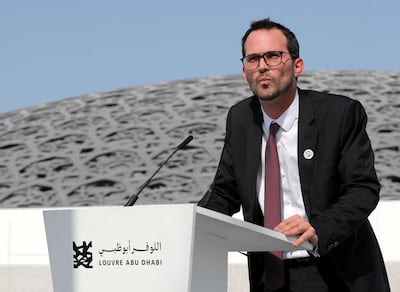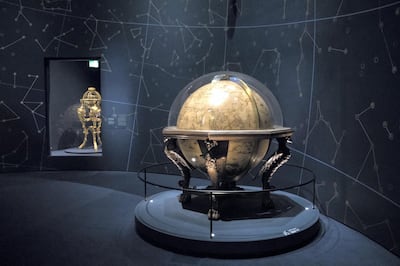"We are a museum of experimentation. We are a museum of meeting points," Manuel Rabaté, the director of Louvre Abu Dhabi, tells me, laying out his vision for the future of the museum as it marks its first 100 days in operation. "We are a museum which is talking about heritage but also trying to give you some keys to understand who you are. These are very important but generic questions. When you match that to exhibitions, what does it mean?"
The museum has now opened the second of its first two temporary exhibitions, each of which lays out an understanding of what Rabaté calls the museum's DNA. The first, From One Louvre to Another, celebrates the museum's progenitor, The Louvre in Paris. "The Louvre means curiosity, generosity, the way you embrace the world," Rabaté says.

The second, Globes: Visions of the World, opened last week dedicated to ways of mapping the world. "Globes is a way to echo something that we have throughout the museum, of understanding how the world works," Rabaté says, sitting in his office overlooking the Arabian Gulf. Light streams through the mashrabiya-like geometric screen covering the building that holds the museum's administrative offices.
“This is a very universal aspiration. Modern cartography is something we found in our museum all over the parcours. The climax is the room dedicated to maps, and in this exhibition we are stretching it in time,” he says.
The exhibition will show the development of the globe from its earliest example – a silver sphere from 200BC showing the positions of the stars – to present-day representations of the world. “These two exhibitions are a way of installing the museum and having new ways of questioning what we are and what we do.”
Opening days of the Louvre
Rabaté arrived late for the interview after overseeing an event outside with the Special Olympics teams – the latest in a series of visits by celebrities and dignitaries that he has hosted. The museum itself has had between 2,000 and 5,000 visitors a day – and on busy days, twice that – from local Emirati and GCC residents to international tourists. Visits from celebrities have been common, particularly during F1 in November. Lindsay Lohan, Martha Stewart, the Manchester City football team, and Adrien Brody, whom Rabaté describes "as very inquisitive, very sensitive to the works", have been among them.
It has also received a number of political figures, from French former presidents François Hollande and Nicolas Sarkozy to Nepal President Bidhya Devi Bhandari, a visit particularly important to the museum's large number of Nepalese staff.
The French-born director describes his feelings after 100 days as being a moment of reflection, in which the staff, having weathered the commotion around the museum's opening – when a fifth of all internet traffic about the UAE was devoted to searches on Louvre Abu Dhabi – can take a moment to plan their steps ahead, particularly in terms of the work to go on display.

While most museums mount temporary exhibitions and rotate their collections, Louvre Abu Dhabi is unusual for the centrality of its loan agreements in terms of what is regularly seen. As part of its founding agreement, it partnered with Agence France-Muséums, a group of 12 establishments to whose collections it has been granted access. This means that what is on display will constantly change as the museum moves ahead.
"What is told in the galleries is the story of mankind," Rabaté says. "It's like a poem or a song where you have 12 chapters. What is changing is the words of the song that you integrate into the poem. We can change a few words or we can change part of the story." Already, in February, a number of highly fragile works were rotated out of display for conservation purposes, such as the Indian miniatures, Japanese prints, early photographs, and the contents of the Sacred Text gallery – including the museum's leaf from the famous 10th-century Blue Quran, which shows the Quran inscribed in gold against blue vellum.
'When we display the Leonardo, a new chapter will be written'
The big change this year will be the unveiling of Leonardo da Vinci's Salvator Mundi (dated to 1500), the most expensive painting yet purchased at auction. Until last December, when it was sold by Christie's in London for US$450 million (Dh1,653m) including fees, it was the last privately owned Leonardo painting – an incredible coup for the world's youngest encyclopaedic museum.
"It's an exceptional piece that arrived in an exceptional way," Rabaté says. The whereabouts of the work, which had been in the collection of Charles I of England after it was painted, were unknown until 1900, when it resurfaced and was attributed to a follower of Leonardo. In 1958 it was sold for a mere £45 – a tiny fraction of its auction price last year even talking inflation into account – and then finally in 2013, to the Russian billionaire who put it up for auction last year.
Initial reports attributed the sale to the Saudi prince Bader bin Abdullah bin Mohammed bin Farhan Al Saud, although the Department of Culture and Tourism – Abu Dhabi was later confirmed to be the new owner of the painting.
"When we display the Leonardo, a new chapter will be written," says Rabaté, noting that for a while next year, Salvator Mundi will be shown alongside Leonardo's La Belle Ferronniére, currently on loan from The Louvre, meaning that Louvre Abu Dhabi will join a select group of institutions with two Leonardo da Vinci paintings.
__________________
Read more:
Stories of collaboration at Louvre Abu Dhabi
Louvre Abu Dhabi launches the world's first roadside gallery
From One Louvre to Another tells the story of the Louvre in Paris
Louvre Abu Dhabi represents cultural understanding through the ages
__________________
The museum is building its collection in more traditional ways as well. Its acquisitions team was at Art Dubai and reportedly bought a work by Senegalese painter Omar Ba from Galerie Templon in Paris.
The museum also recently appointed its first scientific, curatorial and collections management director in Souraya Noujaim, an expert in Islamic art, who will lead the museum's research in collaboration with local universities such as New York Univerity Abu Dhabi and Paris-Sorbonne University Abu Dhabi.
"In terms of the collection, we always have something new coming," Rabaté says. "This is what makes people come – and come back."
He will not be drawn on his favourite artwork or Louvre Abu Dhabi moment so far, but says: “What I’m very proud of is that the opening explained the programme and what we want to achieve.
“We managed to communicate this very original and unique way of being a universal museum.”
From One Louvre to Another runs until April 7; Globes: Visions of the World shows until June 2, at Louvre Abu Dhabi. For more, see www.louvreabudhabi.ae


